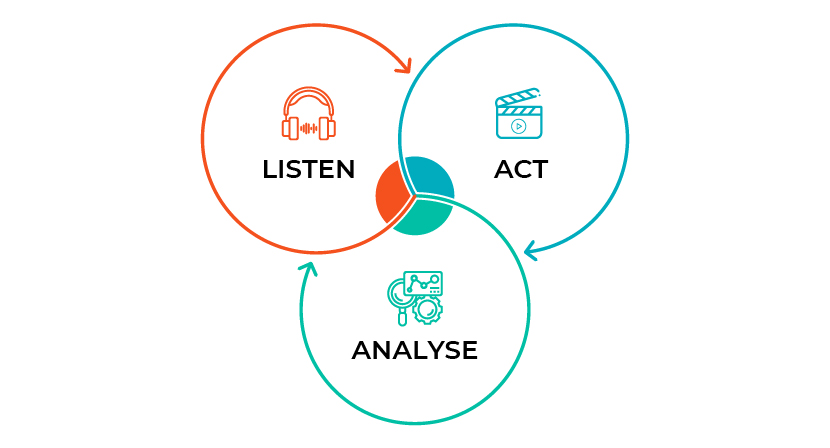Published on July 8, 2021 by Vandana Ahuja
Unlocking organisational success with the Voice of the Customer programme
This is part 1 of 8 our comprehensive series of blogs on the Voice of Customer.
Stay tuned for more blogs.
Perspective
“Voice of the Customer” (VoC) looks to leverage customer feedback on products and services and use the insights to improve sales and boost brand perception.
US content platform and production company Netflix uses such insights – what customers watch, what options they browse through, the time they spend watching, and the time spent scrolling through a particular type of content – to personalize the experience and recommend content. 80% of what its customers watch is what Netflix has recommended, according to a study by Gomez-uribe & Hunt in 2016, resulting in a customer retention rate of 93%.
A VoC programme also provides a platform for customers to share their opinions/ feedback and for the company to understand what customers think of its business, products, or services. It involves gathering customer feedback/input, acknowledging individual concerns, and analysing customer scores and comments to arrive at strategic actions for the company’s growth.
Fact: The VoC concept originated in 1993 as a market research technique that produces a detailed set of customer wants and needs, organised into a hierarchical structure and then prioritised in terms of importance and satisfaction with current alternatives. VoC was first used to improve product development.
The VoC process
Fundamentally, it encompasses three steps – listen, act, and analyse. How the steps are implemented, however, has changed over time.

-
-
Listen: This involves gathering customer feedback via surveys or interviews or from indirect channels, such as usage data, analysis of consumer conversations on social media platforms, or other behavioural metrics. Methods of gathering information include surveys (using web applications, feedback buttons, emails, mobile apps, chats), feedback boxes (quick comments), social media (such as, Facebook comments and tweets), customer interviews, user activity, and usability tests.
-
Another method in use in recent years to capture and analyze consumer behaviour online involves deploying tools, such as Sprinklr, Buzzsumo, and Radian6, that help capture social media “chatter” on a brand or particular topic. Using natural language processing, they measure consumer sentiment – positive, negative, or neutral – to ascertain how consumers perceive a brand or product.
Actionable feedback will depend on asking the right person the right question at the right time.
-
-
Act: Acknowledging feedback from each individual customer is extremely important, as it provides value to the customer immediately by addressing the root cause. There are two important points to this step:
-
Act on feedback immediately – respond to both positive and negative feedback. Acknowledging feedback with a thank you note would help the company maintain its net promoter scores (NPS). Addressing individual issues in a timely manner would also minimize the number of detractors, or unhappy customers. With social media penetration increasing and consumer sentiment being shaped significantly by peer feedback, it is imperative that companies continuously monitor customer feedback on their brands on social media platforms, such as Twitter and Facebook. A number of companies have now set up dedicated grievance-redressal teams to respond to customer feedback received through social media. For example, Amazon, UPS, and Intel have dedicated support accounts on Twitter to meet consumer demand for fast and personalised services. Companies also monitor hashtags and non-tagged mentions of their brands.
-
-
Chatbots are another method companies use to handle individual queries related to a product or service on their digital platforms. An example of this is Zomato resolving the issue of a wrong delivery immediately through a refund.
-
-
-
Have resources who can help close the loop at scale – handling unhappy clients is a big task; so it is vital to have a knowledgeable resource to handle such feedback swiftly.
-
-
The process of providing a solution to each individual client is known as closing the feedback loop.
Fact: Indian Railways started using Twitter in 2016 as its main tool in assisting passengers and addressing grievances related to the service. Travelers can submit complaints and suggestions regarding issues, such as ticketing, medical emergencies, missing luggage, cleanliness, passenger misbehaviour, and the food served.
Millions of passengers have used and appreciated this service so far.
-
-
Analyse: After gathering all the feedback and closing the loop with the client, analyzing and reporting the data collected and insights generated is important to be able to build the feedback into product/service development. Qualitative and quantitative insights help formulate strategic actions for future reference.
-
Quantitative data would include business analytics and outreach analytics. Business analytics encompass all the metrics a company wants to track and measure against a benchmark, such as, NPS trends and loyalty scores. Outreach analytics reflect the performance of customer outreach efforts. The metrics that could be used are total invitations sent, number of responses, the response rate etc. This would enable the company to know whether it needs to change the messaging, the invitations have reached customers, or customers feel their feedback falls on deaf ears.
-
Qualitative data is about analysing customer comments on a product, service, or experience with the company. These insights can be used to identify strategic priorities to improve customer experience.
-
-
In addition to Excel and PowerPoint, companies use other data visualisation tools, such as, Tableau and Power BI.
Fact: Companies that have high NPS grow faster, according to a study by US management consultancy firm, Bain. NPS explained roughly 20-60% of the variation in organic growth rates among competitors. On an average, an industry’s Net Promoter leader outgrew its competitors by a factor greater than two times, according to the study.
The VoC platform provides a coordinated approach towards improving the customer experience, solving challenges, and driving business growth. A 2018 Bain survey found that companies that excel at customer experience (CX) are those that understand and monitor VoC and then integrate that feedback into their solutions and processes. Such companies grow anywhere from 4 - 8% more than the competition. VoC can also be a key input for new product definitions, product quality development, or detailed specifications. We will provide some light on the product aspect in a subsequent blog.
Role of VoC in the customer lifecycle
VoC plays a critical part in the customer lifecycle after the customer has completed a transaction, e.g., sending a survey within a few days of the transaction to get the customer’s view on the process and use of the product. Another example is following up every support ticket with a small survey to close the loop.
A customer lifecycle refers to the process of customer acquisition, retention, and value creation to drive customer loyalty. To better understand the role of VoC in the customer lifecycle, we detail below the main stages of the lifecycle.
1. Reach – Understanding the target group’s media consumption behaviour and reach them through the right media platform such as TV, print, digital media (Facebook, Instagram, Twitter, LinkedIn, Google Ads, etc., email) or road shows.
2. Acquisition – Creating marketing assets/collateral that communicates how the product/service addresses the customer’s pain points. Such marketing collateral can be based on a customer’s profile and communicated via social media or contacting them directly with personalized communication. For example, Spotify entered the Indian market in February 2019 through its “There’s a Playlist for That” campaign, acquiring a substantial 1million subscribers within just a week of launch. This campaign was conceptualized, keeping in mind that users feel very strongly about the kind of music they listen to and want their playlist to express their emotions.
3. Conversion – Conversion relates to moving the customer from considering the product to actually purchasing it. Providing timely assistance to the customer during the buying process – such as chat assistance for online shopping – is of utmost importance. It is also important that all employees, agents, and store associates have access to the same knowledge base. Finally, to increase customer lifecycle value, it is critical to have them registered on the company’s platforms so that up-selling and cross-selling opportunities can be leveraged in the future. It is also important to have a smooth onboarding experience, including, easy access to chat assistance or the support desk for queries. This may be done via surveys or handling queries instantly on digital channels.
4. Retention – Continuously analysing customer feedback is key to finding actionable insights that can lead to stronger customer relationships and retaining customers for longer.
5. Loyalty/advocacy – This refers to turning customers into brand advocates/champions by continuing to provide quality service and support, providing a satisfying customer experience, and taking every opportunity to create an emotional bond. Happy customers lead to more customers.
VoC analytics programmes are proven to improve customer experience and reduce customer churn. A 2018 Bain survey showed that VoC programmes led to 55% higher customer retention.
Conclusion
Understanding and acting on customer feedback and sentiment is the key to success. Data reporting lays the groundwork for compiling strategy and determining the action needed to be taken by each department – from sales to marketing to product development to after-sales support – to overcome shortcomings. It is important that all departments understand the issues and work together towards providing value to customers and driving business growth.
How Acuity Knowledge Partners can help
Acuity Knowledge Partners has been providing research and insight support to diverse stakeholders in the technology sector – tech corporates, tech advisory firms, and tech-focused investors – for over two decades. Equipped with a 360o view, we understand how customer data can be captured and analysed, and how the story emanating thereof can be leveraged to achieve better business outcomes. We help Fortune 500 technology corporations, mid-tier firms, and start-ups leverage customer feedback on people, products, and processes to remain flexible and better serve their customers.
References:
1. The Essential Guide to Voice of the Customer, Gainsight
2. Fuel Your VoC Program With These 8 Tips, CMSWire, Oct 2020
3. How the Net Promoter Score℠ Relates to Growth, Bain & Company
4. Consumer Life Cycle and Profiling: A Data Mining Perspective, Intech Open, April 2019
5. What is the customer lifecycle?, BigCommerce
6. What Are the Stages of the Customer Lifecycle?, Astute Solutions, Oct 2019
8. 7 Examples of Brands Mastering Twitter for Social Customer Care, Top Rank Marketing, 2018
9. How Twitter Helps the Travellers of Indian Railways?, Railrestro, Nov 2019
Tags:
What's your view?
About the Author
Vandana Ahuja is part of the Private Equity and Consulting team in Acuity Knowledge Partners, Gurgaon. Currently working as a strategic consultant for a financial technology firm in the customer experience domain. She has over 10 years of experience in Strategic analysis, Business research and consulting.
She has diverse experience of working with top consulting companies across various industries and geographies. She has managed and executed various consulting projects involving competitor analysis, industry studies, company profiling, survey analysis and strategic recommendations, trend analysis, verbatim and sentiment analysis. She has managed various consulting clients.
She holds a degree in Master of Business Administration (M.B.A)..Show More
Comments
09-Jul-2021 02:09:59 am
Great Insights. It has become increasingly important for businesses to stay close to customers.
Like the way we think?
Next time we post something new, we'll send it to your inbox










